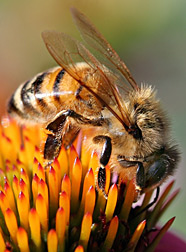|
Read the
magazine
story to find out more. |
|

ARS scientists are pursuing the cause or causes of
Colony Collapse Disorder, which continues to plague honey bees. Photo
courtesy of David Cappaert, Michigan State University, Bugwood.org
|
|

|
Still Seeking a Cause of Colony Collapse
Disorder
By Kim
Kaplan May 5, 2008
The Agricultural Research Service (ARS) and the
Apiary Inspectors of America
have conducted a combined survey of beekeepers to get a snapshot of how well
managed colonies made it through the winter of 2007-08.
Surveyed beekeepers reported a total loss of about 36.1 percent of
their honey bee colonies, up about 13.5 percent from the previous winter.
Losses attributed to Colony Collapse Disorder (CCD) appear to be about the
same, with just over one-third (36 percent) of the operations reporting some
lost colonies in which all adult bees disappeared, a primary symptom of CCD,
according to
Jeff
Pettis, research leader of the
ARS
Bee Research Laboratory in Beltsville, Md.
The combined survey, which was conducted by telephone interview,
checked on nearly 19 percent of the country's 2.44 million colonies.
ARS is continuing to vigorously seek the cause or causes of CCD.
One issue complicating such research is that, so far, researchers only
have samples taken after a CCD incident is reported. With just the one set of
samples, especially since the adult bees have disappeared, researchers cannot
look for specific changes in affected bee colonies preceding the collapse.
To deal with this, in February 2007, Pettis and cooperators from
universities and states began taking samples about every six weeks from
cooperating migratory beekeepers who move their colonies to provide
pollination. Two of the apiaries being sampled had suffered outbreaks of CCD in
2006.
Some of these apiaries did have a CCD incident in late 2007 or early
2008. The stored samples will hopefully give researchers an opportunity to see
what changed, and more direction to find the cause or causes.
Read more
about CCD research by ARS in the May/June issue of Agricultural Research
magazine.
ARS is the U.S. Department of
Agriculture's chief scientific research agency.